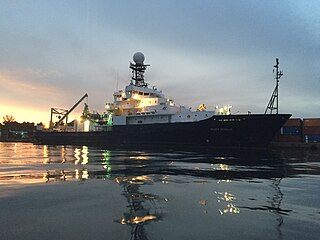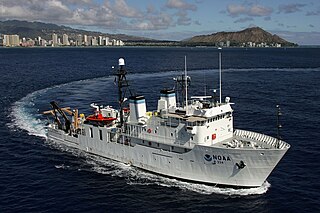
A research vessel is a ship or boat designed, modified, or equipped to carry out research at sea. Research vessels carry out a number of roles. Some of these roles can be combined into a single vessel but others require a dedicated vessel. Due to the demanding nature of the work, research vessels may be constructed around an icebreaker hull, allowing them to operate in polar waters.

BRP Gregorio Velasquez is Philippine Navy's first oceanographic research vessel. It was built by the United States Navy as USNS Melville (T-AGOR-14) for university support of Navy programs. The ship was operated as the research vessel R/V Melville by the Scripps Institution of Oceanography for oceanographic research. As the R/V Melville, it was the oldest active vessel in the academic research fleet, collectively known as the University-National Oceanographic Laboratory System (UNOLS) (UNOLS). The US Government confirmed on 17 November 2015 that the Melville was to be transferred to the Philippine Navy as Excess Defense Articles (EDA)s. The vessel was officially transferred to the Philippines on 28 April 2016 and was commissioned into active service at the same time with the Philippine Navy.

NOAA Ship Rainier is a survey vessel in commission with the National Oceanic and Atmospheric Administration (NOAA). Her primary mission is to chart all aspects of the ocean and sea floor, primarily in Alaska and the Pacific Northwest. The ship is home-ported at the NOAA Marine Operations Center–Pacific in Newport, Oregon.

NOAAS Ronald H. Brown is a Thomas G. Thompson-class blue-water research vessel of the U.S. National Oceanic and Atmospheric Administration, she is NOAA's only Global-Class research ship.

RV Atlantis is a Thomas G. Thompson-class oceanographic research ship, owned by the US Navy and operated by the Woods Hole Oceanographic Institution as part of the University-National Oceanographic Laboratory System (UNOLS) fleet. She is the host vessel of DSV Alvin. She is named for the first research vessel operated by WHOI, the sailboat RV Atlantis, for which the Space ShuttleAtlantis is also named.

RV Knorr was a research vessel formerly owned by the U.S. Navy and operated by the Woods Hole Oceanographic Institution for the U.S. research community in coordination with and as a part of the University-National Oceanographic Laboratory System (UNOLS) fleet. On March 14, 2016, Knorr was officially transferred to the Mexican Navy and renamed Rio Tecolutla. She was replaced at Woods Hole by the RV Neil Armstrong. Knorr is best known as the ship that supported researchers as they discovered the wreck of the RMS Titanic in 1985. R/V Knorr (AGOR-15) has traveled more than a million miles—the rough equivalent of two round trips to the Moon or forty trips around the Earth. Her sister ship is the RV Melville.

R/V Oceanus is a Regional Class research vessel owned by the National Science Foundation, based in Newport, Oregon, and maintained and operated by Oregon State University. The ship was originally delivered to the Woods Hole Oceanographic Institution (WHOI) for operation as a part of the U.S. Academic Research Fleet as a University-National Oceanographic Laboratory System (UNOLS) designated operator. in November, 1975. Oceanus made the first operational cruise in April, 1976 and operated under WHOI for thirty-six years in the Atlantic with some operations in the Mediterranean and Caribbean. The ship was scheduled to be retired in November 2011 but instead was transferred to Oregon State University, College of Earth, Ocean, and Atmospheric Sciences, for operation, replacing sister ship, R/V Wecoma.

R/V Roger Revelle is a Thomas G. Thompson-class oceanographic research ship operated by Scripps Institution of Oceanography under charter agreement with Office of Naval Research as part of the University-National Oceanographic Laboratory System (UNOLS) fleet. The ship is named after Roger Randall Dougan Revelle, who was essential to the incorporation of Scripps into the University of California San Diego.

USNS Vindicator (T-AGOS-3) was a United States Navy Stalwart-class modified tactical auxiliary general ocean surveillance ship that was in service from 1984 to 1993. Vindicator then served in the United States Coast Guard from 1994 to 2001 as the medium endurance cutter USCGC Vindicator (WMEC-3). From 2004 to 2020, she was in commission in the National Oceanic and Atmospheric Administration (NOAA) fleet as the oceanographic research ship NOAAS Hiʻialakai.

USNS Indomitable (T-AGOS-7) was a United States Navy Stalwart-class ocean surveillance ship in service from 1985 to 2002. From 2003 until 18 June 2014, she was in commission in the National Oceanic and Atmospheric Administration (NOAA) as the oceanographic research ship NOAAS McArthur II. As of 2018 it serves as a mother ship now named the Deep Submersible Support Vessel (DSSV) Pressure Drop for the crewed deep-ocean research submersible DSV Limiting Factor.

USNS Titan (T-AGOS-15) was a Stalwart-class modified tactical auxiliary general ocean surveillance ship in service in the United States Navy from 1989 to 1993. From 1996 to 2014, she was in commission in the National Oceanic and Atmospheric Administration (NOAA) fleet as the oceanographic research ship NOAAS Ka'imimoana.
Two ships of the United States Navy have borne the name Thomas G. Thompson, in honor of oceanographer Thomas G. Thompson (1888–1961).

Robert D. Conrad (T-AGOR-3) was a Robert D. Conrad-class oceanographic research ship that operated from 1962 to 1989. The ship, while Navy owned, was operated as the R/V Robert D. Conrad by the Lamont–Doherty Earth Observatory of Columbia University from delivery to inactivation. The ship provided valuable ocean-bottom, particularly seismic profile, information and underwater test data to the U.S. Navy and other U.S. agencies.

USNS James M. Gilliss (T-AGOR-4) was a Robert D. Conrad-class oceanographic research ship acquired by the U.S. Navy in 1962. The ship was operated by the Military Sea Transportation Service and managed by the Naval Oceanographic Office as one of the "Navy Pool" vessels serving various Navy laboratories and projects in the Atlantic Ocean. After active Navy pool service the ship was assigned to the University of Miami to operate as part of the University-National Oceanographic Laboratory System (UNOLS) fleet until 1979.

Thomas G. Thompson (T-AGOR-9) was a Robert D. Conrad-class oceanographic research ship acquired by the U.S. Navy in 1965. The ship was transferred to the University of Washington for operation as part of the University-National Oceanographic Laboratory System (UNOLS) fleet on 21 September 1965. In 1988 the ship went out of UNOLS service. The ship, retaining the previous name, was designated by the Navy as IX-517 assigned to the Mare Island Naval Shipyard for general naval research. Thomas G. Thompson was later renamed Pacific Escort II with the same designation. On 7 May 1997 the Navy renamed the ship Gosport and transferred the ship to the Norfolk Naval Shipyard available for hire as a multi purpose platform from the shipyard. The ship, placed out of service and struck from the register on 27 February 2004, was sunk as part of a NATO exercise 14 November 2004.

Thomas Washington (T-AGOR-10) was a Robert D. Conrad-class oceanographic research ship delivered to the U.S. Navy in 1965. The ship was owned by the Navy but assigned to the Scripps Institute of Oceanography, University of California, La Jolla, California and operated as R/VThomas Washington from delivery to inactivation.
Gyre (T-AGOR-21), best known as RV Gyre, was the lead ship of her class of oceanographic research ships acquired by the U.S. Navy in 1973 for assignment to the University-National Oceanographic Laboratory System (UNOLS) fleet of Navy owned ships. Gyre was operated by the Texas A&M University School of Oceanography as part of the Navy owned UNOLS fleet until stricken 17 August 1992 and transferred to the university under a program transferring ships to states, schools and other public institutions. The university operated the ship until sale in December 2005.

NOAAS Discoverer, originally USC&GS Discoverer, was an American Oceanographer-class oceanographic research vessel in service in the United States Coast and Geodetic Survey from 1966 to 1970 and in the National Oceanic and Atmospheric Administration (NOAA) from 1970 to 1996.
RV Neil Armstrong (AGOR-27) is the designation for a new oceanographic research ship, first of the Neil Armstrong-class research vessels, to be owned by the United States Navy and operated by Woods Hole Oceanographic Institution. Secretary of the Navy Ray Mabus announced on September 24, 2012, that the research vessel was to be named after Neil Armstrong, the first person to walk on the Moon and a former naval aviator who served in the Korean War.

















